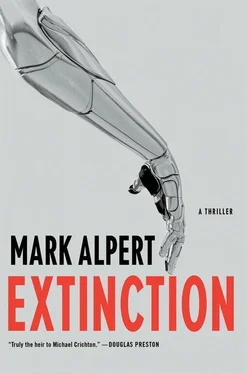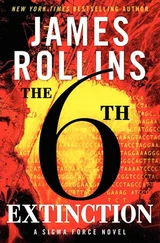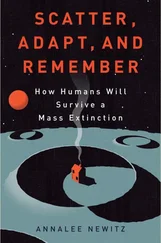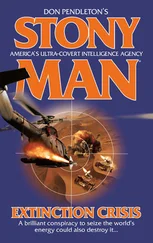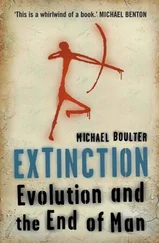The crowd fell into an uneasy silence. Jim guessed that the other people in the audience were just as shocked as he was. Arvin had thrown away his natural eyesight to make this demonstration.
“I know what you’re thinking,” Arvin said, still grinning. “Old man Conway is off his rocker, right? What kind of loon would blind himself just to get the attention of a few potential investors?” He chuckled, but no one else joined in. “My decision, though, was quite logical. In the past, the vision provided by our cameras and retinal implants was, at best, roughly equivalent to natural eyesight. But now, thanks to improvements in both the hardware and software, it’s far superior. Let me show you.”
Stepping to the left side of the stage, he pulled a remote control from his pocket. A moment later, a short, squat robot on caterpillar treads rolled onstage from the right. It looked like a mobile end table. Resting on the robot’s flat top was a bottle of Chivas Regal, and extending from its side was a mechanical arm. This appendage, Jim noticed, had the same design as his Terminator prosthesis.
“This is my delivery boy,” Arvin said. “His name is Robbie. He rolls into my lab every evening at six and brings me a scotch and soda. He also delivers my reading materials. Robbie, show the audience my favorite book.”
The robot’s arm stretched toward its flat top and picked up a rectangular object lying next to the bottle of scotch. It was a thin, gray e-book reader. One of the mechanical fingers pressed the e-reader’s power button, and a book title appeared in big letters on the screen: I, ROBOT.
Arvin smiled. “Can someone in the audience please call out a random number? Nothing higher than 3,493, please. The electronic book is divided into 3,493 locations.”
Someone called out the number 2,583. The e-reader’s screen automatically turned to that page.
“Now, can anyone read the words at the top of the page? Perhaps someone in front?”
Jim was on the right side of the front row, less than fifteen feet from the e-reader, but even so, the text on the screen was much too small for him to read. Some of the people in his row leaned forward and squinted, but they couldn’t read it either.
“No? Well, I’ll read it then.” Arvin paused for dramatic effect. He was all the way on the other side of the stage, at least twenty-five feet from the robot. He cleared his throat and began to read. “‘There’s just one more thing. You must make a special effort to answer simply. Have you been entirely clear about the interstellar jump?’”
The crowd murmured in disbelief. Arvin smiled again. Then he shouted, “Robbie, throw!” and the mechanical arm hurled the e-reader across the stage. The thing pinwheeled straight at Arvin’s head, but the old man raised his hand and deftly caught it. “Not bad, eh? My ocular cameras and retinal implants give me enhanced motion-detection capabilities. Thanks to the new system, I can spot a curveball faster than Alex Rodriguez.”
The murmurs grew louder. Arvin tossed the e-reader back to Robbie, who caught it with the mechanical arm and moved offstage. Then the old man reached into his pocket once again and pulled out a small piece of silvery foil about the size of a postage stamp. “The implant is a biocompatible sheath that lines the back of each eye. It’s imprinted with more than a million electrodes, which is a hundredfold increase over earlier models.” Using his pinky, Arvin pointed at a tiny computer chip attached to the foil. “But the real key to the implant’s success is this microprocessor. The ocular camera wirelessly transmits its video to this chip, which organizes and processes the visual information in the same way that a natural retina does. Then the electrodes feed the processed signals to the optic nerves that lead to the brain. In essence, the chip translates the camera video into neural code. For the first time ever, we can send a signal to the brain in the brain’s own language .”
The audience was chattering wildly now. Jim could see why the venture capitalists were so excited. Arvin’s new implants weren’t just for the blind. They would also appeal to perfectly healthy people who wished to enhance their eyesight. Baseball players, say. Or sharpshooters.
Arvin held out his hands, trying to quiet the crowd. “Before we get ahead of ourselves, I’m obliged to report the bad news. Obviously we’ll need to conduct clinical trials before the FDA approves these implants. But if Singularity attracts some new investors and raises enough money, we can complete the trials in less than a year.” He grinned confidently. Then his face turned sober. “And there’s another piece of bad news. Our implants won’t help everyone. They won’t work for people whose retinas have been completely lost, because they have no nerve cells to receive the signals. We’ve tried to help these patients by developing implants that send the video signals directly to the brain, but unfortunately those experiments have failed. Direct stimulus of the brain’s visual cortex can allow a blind person to perceive crude patterns, but it’s not even close to the kind of vision provided by the retinal implants.”
The bad news didn’t seem to diminish the crowd’s enthusiasm. If anything, the chatter grew more feverish.
“But one of the great truths of science is that even failures can teach us something,” Arvin continued. “During the course of our experiments with the brain implants, we learned a lot about the visual system. We discovered that after the visual cortex receives the signals from the optic nerve, it relays the information to other parts of the brain. And we found that one of these regions, the pulvinar nucleus, combines the visual signals with information from the other senses. This region is located deep inside the brain, on both sides of the structure called the thalamus. The pulvinar nucleus is about a centimeter wide and shaped like a cushion, so anatomists named it after the Latin word for cushion, pulvinus .”
The venture capitalists started to get restless, shifting in their seats. They didn’t want to hear about the science. They wanted to hear more about superhuman vision. Because it was a freakin’ gold mine.
“We focused our attention on the pulvinar nucleus because it seemed to be one of the places in the brain where perception takes place. Where the most important information from the visual field is sent after it’s been deciphered by the cortex. Using implanted arrays of electrodes, we tried to deliver a visual signal to this part of the brain, and as I said, we failed. But as we did our experiments, an amazing thing happened. Although we couldn’t deliver a visual signal directly to the brain, we found that we could retrieve one.”
Arvin moved to the center of the stage, where a laptop had been placed on a round table beneath the giant video screen. He sat down in a chair beside the table, then pulled aside his long white hair to reveal a patch of shaved skin on his scalp, just above his right ear. A small silver disk was embedded in the center of the patch. “As you can see, I was the primary human subject in this experiment. Implanted in my pulvinar nucleus is a device that acts like a neural wiretap. It picks up the electromagnetic signals generated by millions of brain cells, and then it amplifies and wirelessly transmits those signals to this microprocessor on the outside of my skull.” Arvin tapped the silver disk in his scalp. “I call this processor the Dream-catcher. It’s similar to the microchip used in our retinal implants, but in the Dream-catcher the translation process is reversed. Whereas the retinal implant converts a video feed to neural signals that are sent to the brain, the Dream-catcher converts the neural signals of my brain into digital images that can be transmitted to a computer. Please take a look at the screen.”
Читать дальше
